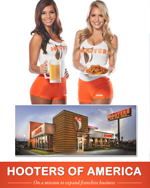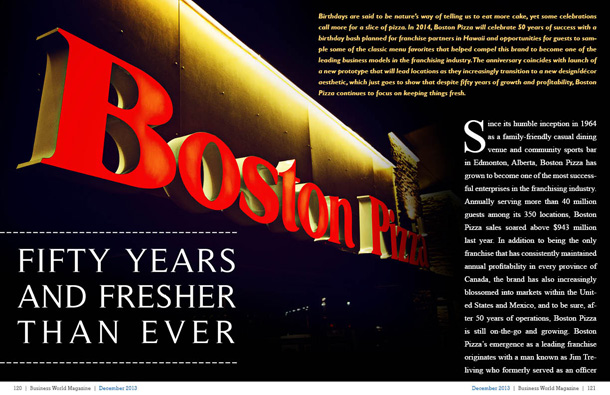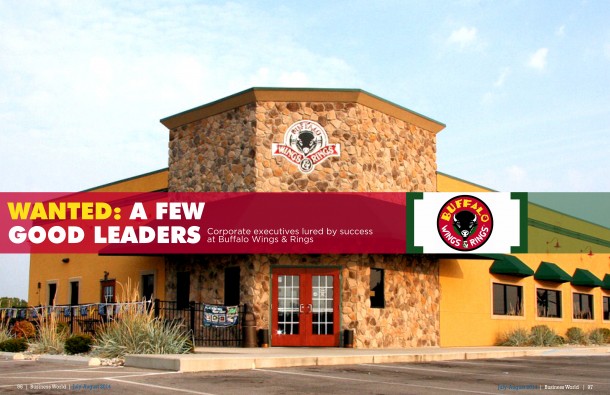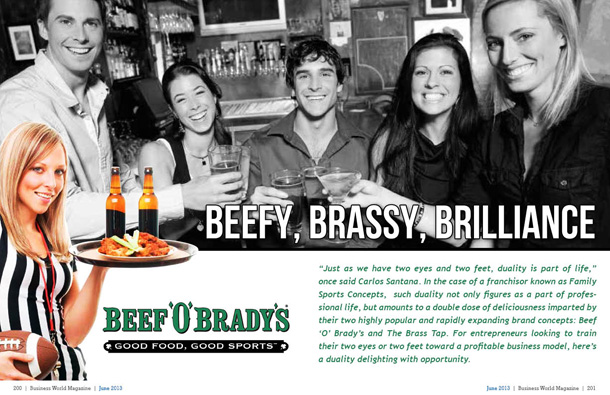
Hooters of America
On a mission to expand franchise business

One of the most recognized brands on the planet is once again spreading its wings and introducing more people to a distinctively tacky yet unrefined version of happiness.
Encouraged by the consumer response to several initiatives designed to improve the guest experience, Atlanta-based Hooters of America is encountering renewed interest among new and existing franchisees to invest in new store development opportunities.
After opening 17 new restaurants last year, including a company-operated prototype conversion on International Drive in Orlando, Hooters is seeing its momentum build. With a new store development pipeline quickly approaching 100 units to be opened over the next four years, the brand is poised for accelerated growth, and locally-owned and operated franchise outlets will drive nearly all of that growth in new and existing markets.
That blueprint would significantly change the company’s current ratio of franchise-owned to corporate-owned facilities. According to Mark Whittle, senior vice president of global development, Hooters entered 2014 with 225 franchised restaurants and 189 company operated sites. All of the company operated restaurants are in the United States, while 69 of the franchised stores are outside of the U.S.  “We are big believers in the franchise model,” says Whittle, “and we expect that more than 90 percent of our unit growth will be driven by franchisees.â€
A QUESTION OF SYSTEM LEADERSHIPÂ
Whittle says the lean toward more franchises doesn’t mean Hooters of America sees no role for company operated restaurants. To the contrary, Whittle says being an operator enhances HOA’s credibility as a franchisor. “We have great respect for our franchisees and their capital,†he says. “Therefore, we believe it is our responsibility as the franchisor to put our capital at risk to prove a model before asking our franchisees to invest. This approach ensures alignment of economic interest which we see as a pre-requisite for effective system leadership.” According to Whittle, Hooters took this approach with the launch of its successful remodel program in 2013.
“We feel very bullish about the business and are very pleased with the consumer response to the 19 HOA stores we remodeled in 2013,” Whittle says. “We expect to remodel more than 25 company operated stores alone in 2014. With the new store growth we are experiencing in the franchise system, particularly internationally, the Hooters brand stands to benefit from a meaningful injection of capital investment.â€
According to Whittle, Hooters will continue to open new company operated stores, though the annual number will be in the low single digits. The cost to construct a new store is influenced by many factors such as size and location, says Whittle, but he pegs the average range between $1.5 and $2 million. While Hooters’ franchisees will be opening the vast majority of new locations, Whittle says his design team in Atlanta will be hard at work looking for additional value-management opportunities. “Our franchisees finance their construction costs and any non-value added cost we can eliminate goes right back into the pockets of our franchisees, providing them with additional firepower to invest in growth. Again, it’s about responsible system leadership.”
THE WORLD IS A BIG PLACE
According to Whittle, Hooters of America believes that the franchise model is particularly relevant for international store growth. “More than half of the stores in our development pipeline today will be opened abroad. The world is a big place and the franchise system is ideal for expanding a restaurant brand’s global footprint. Of course, you have to select the right franchisees,” Whittle says. Hooters is very careful to ensure prospective franchisees have the finances and operating acumen to successfully run the unique casual dining concept.
“Qualifying franchisees is important in any market, but because of the distance special attention must be paid to vetting international franchisees,” Whittle says. He takes it as a great sign that during this time of renewed unit growth, Hooters international AUVs have increased almost 50 percent over the past three years.
Hooters believes locally owned and operated restaurants deliver a better experience for customers in markets as culturally diverse as China, Brazil or South Africa. But that appreciation for a local touch doesn’t mean that the franchisor isn’t paying attention. The home office is involved with site selection and store design, and Whittle says the company strives to “reach out and touch†its franchisees several times a year, in the form of with operational support visits to the restaurants.
“We offer a large amount of support to the franchisees,†he says. “Ideally, a customer going into a Hooters should not be able to tell if its company owned or franchised. Regardless of ownership, every Hooters exists for one reason – to make people happy.”
MAINTAINING THE STANDARDS
There is some leeway in terms of store design as it relates to specific markets. For example, feedback from Hooters’ franchisee in China suggested that some restaurant design elements that are successful in the United States might not resonate with Chinese guests. After reviewing the proposed changes, Whittle’s team granted its approval.
“I don’t think every Hooters has to look identical. We should allow for regional and local flavor into our restaurant designs,†he says. “Local flavor can be introduced into the store in a variety of ways that don’t compromise the brand’s essence. Sometimes, a localized artifact package is sufficient to convey a sense of local relevance. In other cases, some modest changes to the finishes can make a big difference.”
Some things, however, will remain consistent throughout the world in the Hooters restaurant design.
Whittle says roughly 85 percent of the menu will be comprised of what the company calls “core items,†which leaves about 15 percent of the selections open to regionalization, subject to review and approval by the Hooters product development team. Often the biggest variances take the form of locally brewed beer assortment. However, it is often important to include locally relevant food items to meet the tastes of the local customer base.
These “exceptions,” while often important, are only approved after careful consideration of concept relevance. Too much deviation and you’ve lost the brand, says Whittle. And while exceptions are granted to optimize item assortment, don’t look for compromise when it comes to quality. “At the end of the day, we are in the restaurant business,” Whittle says. “We serve great tasting, fresh American fare that is perfect for socializing with friends and family. That is what our guests expect from us in every corner of the world.â€
THE PURSUIT OF HAPPINESS
There is one core offering for which there will never be a substitute: the world famous, iconic Hooters girls.
“Hooters girls are not just the face of our brand, they are part of Americana, and people all over the world visit Hooters for a uniquely American experience,” Whittle says. “Remember, our mission in life is to make people happy. So we try to not overcomplicate it. Life and liberty? Those are a little beyond our reach. But happy we can do. And it’s pretty hard not to be happy when enjoying fresh wings and cold beer in the company of friends, family and the one and only Hooters girls.â€
INTROVERTS NEED NOT APPLY
Whittle says Hooters is taking “a more proactive approach†when it comes to identifying the right candidates, rather than simply waiting for the right person/organization to look them up.
“A perception grew over time that Hooters was not interested in introducing new franchisees to the system,†he says. “That may have been a reasonable assumption in the past, but I can tell you that is certainly not the case today. We are not sitting and waiting for the phone to ring. We’re out there saying, ‘OK, there are multiple-unit restaurant operators in this market, who are the best ones? Let’s go talk to them.’”
“One of the great things about selling this concept is that you never have to overcome a brand-awareness hurdle,†Whittle says. “Whether here in the U.S. or abroad, everyone knows Hooters and most people have a genuine fondness for the brand.”
The ideal franchisee, he says, is someone who’s operated multiple restaurants in a given market, or someone who’s entering the project with access to an experienced partner. Also key, in addition to financial wherewithal, is a desire to develop multiple restaurants.
Whittle says Hooters looks for potential franchisees with $1.5 million in available cash on hand, and a $2.5 million net worth, but these levels can vary depending upon the market.
But it’s not simply about the money, Whittle says. Hooters is first and foremost a people business.
“We want our associates and our franchisees to be passionate about the business and the concept, and to have a desire to be with people,†he says. “This is a people business and we happen to sell food. Introverts don’t seem to be successful, or, if you’re an introvert by nature, you need to have the outgoing sort of people working with you. If Warren Buffett called me tomorrow, the first question I’d ask him is ‘Who is going to operate the restaurant?’ and if he couldn’t give me an answer, I’d ask him to get an operations partner secured, then we could talk about Hooters.â€
In terms of markets, Whittle says, Hooters is predominantly looking at places with populations of at least 100,000 or 125,000 with an upper-middle income base, a high preponderance of daytime activity and a strong residential base surrounding the site.  In addition, Hooters prefers sites that are within close proximity to regional malls, theatres and/or sports arenas to help drive evening and late night traffic.  Some of the most successful Hooters restaurants are located in the hearts of large downtown areas.
HOOTIE GETS A FACELIFT
“We turned 30 last year so we joked that it was time Hootie got a facelift,” Whittle says. This particular facelift has been pretty comprehensive, and, according to Whittle, is an ongoing process. “We are simply trying to improve, to be better at everything we do,†he says. “The new prototype, the remodels, the upgraded AV experience and premium sports packages, the on-going menu work – all of these efforts have been undertaken to deliver to our guests the best possible experience when they visit our stores.â€
Whittle says it’s all part of making people happy. And he says it’s important to pay attention to the needs of franchisees, too. “We work hard to support our franchisees, to help them be successful,†he says. “Whenever we see an opportunity to leverage our collective scale on their behalf, we do. And we extend to them the full benefit of our buying power. If they grow, we grow. It is in our interest to have a healthy base of franchisees who are anxious to reinvest in their business.
“It’s incredible how successful this brand has been for 30 years. And it is a testament to its strength that it is every bit as relevant today as it was in the 1980s. We believe that there is no reason that the next 30 years can’t be even more successful than the last. After all, haven’t we learned by now that the pursuit of happiness never goes out of style?â€







